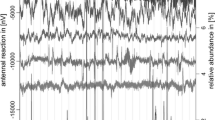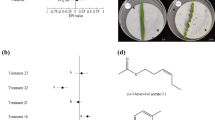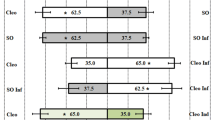Abstract
Herbivore-induced plant volatiles (HIPVs) emitted from lima bean leaves infested with the two-spotted spider mites Tetranychus urticae strongly attract the predatory mites Neoseiulus californicus. Among these HIPVs, methyl salicylate and linalool can attract the predators. Three green-leaf volatiles (GLVs) of (Z)-3-hexen-1-ol, (Z)-3-hexenyl acetate and (E)-2-hexenal, found in the odor blends from T. urticae-infested leaves and physically damaged leaves, can also attract the predators. To search for a strong predator attractant, the olfactory responses of N. californicus to each synthetic compound or their combinations were investigated in a Y-tube olfactometer. When presented a choice between a mixture of the five compounds (i.e. the two HIPVs and the three GLVs) and T. urticae-infested leaves, N. californicus did not discriminate between these odor sources. The same trend was observed when either a mixture of the two HIPVs or methyl salicylate vs. T. urticae-infested leaves were compared. In contrast, the predators preferred T. urticae-infested leaves to linalool, each of the three GLVs, or a mixture of the three GLVs. These results indicated that methyl salicylate is a strong predator attractant, and its potential attractiveness almost equaled that of the blend of HIPVs from T. urticae-infested leaves.



Similar content being viewed by others
References
Croft BA, Monetti LN, Pratt PD (1998) Comparative life histories and predation types: are Neoseiulus californicus and N. fallacis (Acari:Phytoseiidae) similar type II selective predators of spider mites? Environ Entomol 27:531–538
De Boer JG, Posthumus MA, Dicke M (2004) Identification of volatiles that are used in discrimination between plants infested with prey or nonprey herbivores by a predatory mite. J Chem Ecol 30:2215–2230. doi:10.1023/B:JOEC.0000048784.79031.5e
De Boer JG, Snoeren TAL, Dicke M (2005) Predatory mites learn to discriminate between plant volatiles induced by prey and nonprey herbivores. Anim Behav 69:869–879. doi:10.1016/j.anbehav.2004.07.010
Dicke M (1999) Are herbivore-induced plant volatiles reliable indicators of herbivore identity to foraging carnivorous arthropods? Entomol Exp Appl 91:131–142. doi:10.1023/A:1003608019062
Dicke M, van Beek TA, Posthumus MA, Ben Don N, van Bokhoven H, De Groot AE (1990a) Isolation and identification of volatile kairomone that affects acarine predator–prey interactions: involvement of host plant in its production. J Chem Ecol 16:381–396. doi:10.1007/BF01021772
Dicke M, Sabelis MW, Takabayashi J, Bruin J, Posthumus MA (1990b) Plant strategies of manipulating predator–prey interactions through allelochemicals: prospects for application in pest control. J Chem Ecol 16:3091–3117. doi:10.1007/BF00979614
Dicke M, Takabayashi J, Posthumus MA, Schütte C, Krips OE (1998) Plant–phytoseiid interactions mediated by herbivore-induced plant volatiles: variation in production of cues and in responses of predatory mites. Exp Appl Acarol 22:311–333. doi:10.1023/A:1024528507803
Drukker B, Bruin J, Sabelis MW (2000a) Anthocorid predators learn to associate herbivore-induced plant volatiles with presence or absence of prey. Physiol Entomol 25:260–265. doi:10.1046/j.1365-3032.2000.00190.x
Drukker B, Bruin J, Jacobs G, Kroon A, Sabelis MW (2000b) How predatory mites learn to cope with variability in volatile plant signals in the environment of their herbivorous prey. Exp Appl Acarol 24:881–895. doi:10.1023/A:1010645720829
Dwumfour EF (1992) Volatile substances evoking orientation in the predatory flowerbug Anthocoris nemorum (Heteroptera: Anthocoridae). Bull Entomol Res 82:465–469
Easterbrook MA, Fitzgerald JD, Solomon MG (2001) Biological control of strawberry tarsonemid mite Phytonemus pallidus and two-spotted spider mite Tetranychus urticae on strawberry in the UK using species of Neoseiulus (Amblyseius) (Acari: Phytoseiidae). Exp Appl Acarol 25:25–36. doi:10.1023/A:1010685903130
Garcia-Mari F, Gonzalez-Zamora JE (1999) Biological control of Tetranychus urticae (Acari: Tetranychidae) with naturally occurring predators in strawberry plantings in Valencia, Spain. Exp Appl Acarol 23:487–495
Greco NM, Liljesthrom CG, Sanchez NE (1999) Spatial distribution and coincidence of Neoseiulus californicus and Tetranychus urticae (Acari: Phytoseiidae, Tetranychidae) on strawberry. Exp Appl Acarol 23:567–580
Helle W, Sabelis MW (1985a) Spider mites: their biology, natural enemies and control. World crop pests, vol 1A. Elsevier, Amsterdam
Helle W, Sabelis MW (1985b) Spider mites: their biology, natural enemies and control. World crop pests, vol 1B. Elsevier, Amsterdam
Huffaker CB, Van de Vrie M, McMurtry JA (1970) Ecology of tetranychid mites and their natural enemies: a review. II. Tetranychid enemies populations and their possible control by predators: An evaluation. Hilgardia 40:391–458
Ishiwari H, Suzuki T, Maeda T (2007) Essential compounds in herbivore-induced plant volatiles that attract the predatory mite Neoseiulus womersleyi. J Chem Ecol 33:1670–1681
James DG (2003a) Field evaluation of herbivore-induced plant volatiles as attractants for beneficial insects: methyl salicylate and the green lacewing, Chrysopa nigricornis. J Chem Ecol 29:1601–1609
James DG (2003b) Synthetic herbivore-induced plant volatiles as field attractants for beneficial insects. Environ Entomol 32:977–982
James DG (2005) Further field evaluation of synthetic herbivore-induced plant volatiles as attractants for beneficial insects. J Chem Ecol 31:481–495
James DG, Price TS (2004) Field-testing of methyl salicylate for recruitment and retention of beneficial insects in grapes and hops. J Chem Ecol 30:1613–1628
Kappers IF, Aharoni A, van Herpen TWJM, Luckerhoff LLP, Dicke M, Bouwmeester HJ (2005) Genetic engineering of terpenoid metabolism attracts bodyguards to Arabidopsis. Science 309:2070–2072
Maeda T, Liu Y (2006) Intraspecific variation in the olfactory response of the predatory mite Neoseiulus womersleyi Schicha (Acari: Phytoseiidae) to different amount of spider mite-infested plant volatiles. Appl Entomol Zool 41:209–215
Maeda T, Takabayashi J (2001) Production of herbivore-induced plant volatiles and their attractiveness to Phytoseiulus persimilis (Acari: Phytoseiidae) with changes of Tetranychus urticae (Acari: Tetranyuchidae) density on a plant. Appl Entomol Zool 36:47–52
Maeda T, Liu Y, Ishiwari H, Shimoda T (2006) Conditioned olfactory responses of a predatory mite Neoseiulus womersleyi, to volatiles from prey-infested plants. Entomol Exp Appl 121:167–175
McMurtry JA, Croft BA (1997) Life-styles of phytoseiid mites and their roles in biological control. Ann Rev Entomol 42:291–321
Mumm R, Posthumus MA, Dicke M (2008) Significance of terpenoids in induced indirect plant defence against herbivorous arthropods. Plant Cell Environ 31:575–585
Nachappa P, Margolies DC, Nechols JR, Loughin T (2006) Phytoseiulus persimilis response to herbivore-induced plant volatiles as a function of mite-days. Entomol Exp Appl 40:231–239
Rott AS, Ponsonby DJ (2000) Improving the control of Tetranychus urticae on edible glasshouse crops using a specialist coccinellid (Stethorus punctillum Weise) and a generalist mite (Amblyseius californicus McGregor) as biocontrol agents. Biocontrol Sci Technol 10:487–498
Shimoda T, Takabayashi J (2001) Response of Oligota kashmirica benefica, a specialist insect predator of spider mites, to volatiles from prey-infested leaves under both laboratory and field conditions. Entomol Exp Appl 101:41–47
Shimoda T, Takabayashi J, Ashihara W, Takafuji A (1997) Response of predatory insect Scolothrips takahashii toward herbivore-induced plant volatiles under laboratory and field conditions. J Chem Ecol 23:2033–2048
Shimoda T, Ozawa R, Arimura G, Takabayashi J, Nishioka T (2002) Olfactory responses of two specialist insect predators of spider mites toward plant volatiles from lima bean leaves induced by jasmonic acid and/or methyl salicylate. Appl Entomol Zool 37:535–541
Shimoda T, Ozawa R, Sano K, Yano E, Takabayashi J (2005) The involvement of volatile infochemicals from spider mites and from food–plants in prey location of the generalist predatory mite Neoseiulus californicus. J Chem Ecol 31:2019–2032
Shiojiri K, Maeda T, Arimura G, Ozawa R, Shimoda T, Takabayashi J (2002) Functions of plant infochemicals in tritrophic interactions between plants, herbivores and carnivorous natural enemies. Jpn J Appl Entomol Zool 46:117–133 (in Japanese)
Sokal RR, Rohlf FJ (1995) Biometry, 3rd edn. W. H. Freeman and Company, New York
Steinberg S, Dicke M, Vet LEM (1993) Relative importance of infochemicals from first and second trophic level in long-range host location by the larval parasitoid Cotesia glomerata. J Chem Ecol 19:47–59
Symondson WOC, Sunderland KD, Greenstone MH (2002) Can generalist predators be effective biocontrol agents? Annu Rev Entomol 47:561–594
Takabayashi J, Dicke M (1996) Plant–carnivore mutualism through herbivore-induced carnivore attractants. Trends Plant Sci 1:109–113
Takabayashi J, Dicke M, Takahashi S, Posthumus MA, van Beek TA (1994) Leaf age affects composition of herbivore-induced synomones and attraction of predatory mites. J Chem Ecol 20:373–386
Takahashi H, Takafuji A, Takabayashi J, Yano S, Shimoda T (2001) Seasonal occurrence of specialist and generalist insect predators of spider mites and their response to volatiles from spider-mite-infested plants in Japanese pear orchards. Exp Appl Acarol 25:393–402
Van de Vrie M, McMurtry JA, Huffaker CB (1972) Ecology of tetranychid mites and their natural enemies: a review III. Biology, ecology, and pest status, and host–plant relations of tetranychids. Hilgardia 41:343–432
Van Wijk M, De Bruijn PJA, Sabelis MW (2008) Predatory mite attraction to herbivore-induced plant odor is not a consequence of attraction to individual herbivore-induced plant volatiles. J Chem Ecol 34:791–803
Acknowledgments
I thank Kimiko Kanbe and Yumiko Togashi for rearing the mites and plants. This research was supported partly by a Grant-in-Aid for Scientific Research from the Japan Society for the Promotion of Science [Kakenhi (B): No. 19380188].
Author information
Authors and Affiliations
Corresponding author
Rights and permissions
About this article
Cite this article
Shimoda, T. A key volatile infochemical that elicits a strong olfactory response of the predatory mite Neoseiulus californicus, an important natural enemy of the two-spotted spider mite Tetranychus urticae . Exp Appl Acarol 50, 9–22 (2010). https://doi.org/10.1007/s10493-009-9275-x
Received:
Accepted:
Published:
Issue Date:
DOI: https://doi.org/10.1007/s10493-009-9275-x




